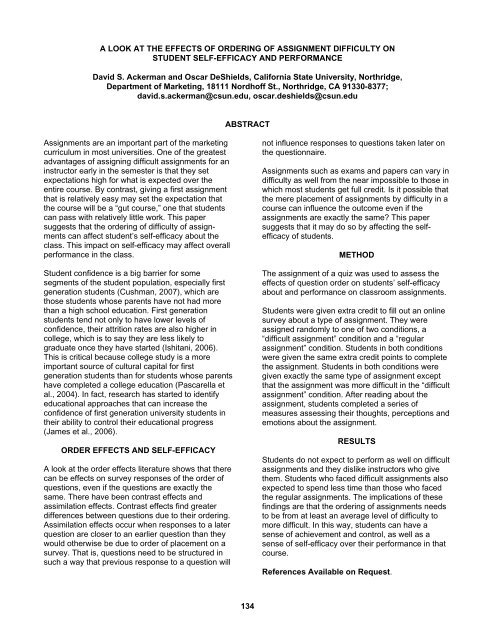2008 - Marketing Educators' Association
2008 - Marketing Educators' Association
2008 - Marketing Educators' Association
Create successful ePaper yourself
Turn your PDF publications into a flip-book with our unique Google optimized e-Paper software.
A LOOK AT THE EFFECTS OF ORDERING OF ASSIGNMENT DIFFICULTY ON<br />
STUDENT SELF-EFFICACY AND PERFORMANCE<br />
David S. Ackerman and Oscar DeShields, California State University, Northridge,<br />
Department of <strong>Marketing</strong>, 18111 Nordhoff St., Northridge, CA 91330-8377;<br />
david.s.ackerman@csun.edu, oscar.deshields@csun.edu<br />
Assignments are an important part of the marketing<br />
curriculum in most universities. One of the greatest<br />
advantages of assigning difficult assignments for an<br />
instructor early in the semester is that they set<br />
expectations high for what is expected over the<br />
entire course. By contrast, giving a first assignment<br />
that is relatively easy may set the expectation that<br />
the course will be a “gut course,” one that students<br />
can pass with relatively little work. This paper<br />
suggests that the ordering of difficulty of assignments<br />
can affect student’s self-efficacy about the<br />
class. This impact on self-efficacy may affect overall<br />
performance in the class.<br />
Student confidence is a big barrier for some<br />
segments of the student population, especially first<br />
generation students (Cushman, 2007), which are<br />
those students whose parents have not had more<br />
than a high school education. First generation<br />
students tend not only to have lower levels of<br />
confidence, their attrition rates are also higher in<br />
college, which is to say they are less likely to<br />
graduate once they have started (Ishitani, 2006).<br />
This is critical because college study is a more<br />
important source of cultural capital for first<br />
generation students than for students whose parents<br />
have completed a college education (Pascarella et<br />
al., 2004). In fact, research has started to identify<br />
educational approaches that can increase the<br />
confidence of first generation university students in<br />
their ability to control their educational progress<br />
(James et al., 2006).<br />
ORDER EFFECTS AND SELF-EFFICACY<br />
A look at the order effects literature shows that there<br />
can be effects on survey responses of the order of<br />
questions, even if the questions are exactly the<br />
same. There have been contrast effects and<br />
assimilation effects. Contrast effects find greater<br />
differences between questions due to their ordering.<br />
Assimilation effects occur when responses to a later<br />
question are closer to an earlier question than they<br />
would otherwise be due to order of placement on a<br />
survey. That is, questions need to be structured in<br />
such a way that previous response to a question will<br />
ABSTRACT<br />
134<br />
not influence responses to questions taken later on<br />
the questionnaire.<br />
Assignments such as exams and papers can vary in<br />
difficulty as well from the near impossible to those in<br />
which most students get full credit. Is it possible that<br />
the mere placement of assignments by difficulty in a<br />
course can influence the outcome even if the<br />
assignments are exactly the same? This paper<br />
suggests that it may do so by affecting the selfefficacy<br />
of students.<br />
METHOD<br />
The assignment of a quiz was used to assess the<br />
effects of question order on students’ self-efficacy<br />
about and performance on classroom assignments.<br />
Students were given extra credit to fill out an online<br />
survey about a type of assignment. They were<br />
assigned randomly to one of two conditions, a<br />
“difficult assignment” condition and a “regular<br />
assignment” condition. Students in both conditions<br />
were given the same extra credit points to complete<br />
the assignment. Students in both conditions were<br />
given exactly the same type of assignment except<br />
that the assignment was more difficult in the “difficult<br />
assignment” condition. After reading about the<br />
assignment, students completed a series of<br />
measures assessing their thoughts, perceptions and<br />
emotions about the assignment.<br />
RESULTS<br />
Students do not expect to perform as well on difficult<br />
assignments and they dislike instructors who give<br />
them. Students who faced difficult assignments also<br />
expected to spend less time than those who faced<br />
the regular assignments. The implications of these<br />
findings are that the ordering of assignments needs<br />
to be from at least an average level of difficulty to<br />
more difficult. In this way, students can have a<br />
sense of achievement and control, as well as a<br />
sense of self-efficacy over their performance in that<br />
course.<br />
References Available on Request.


